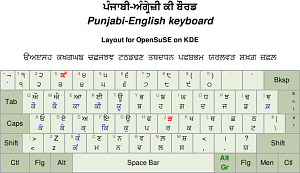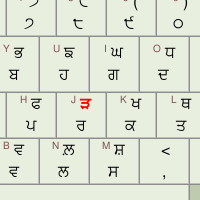This is an HTML file giving the layout on a QWERTY keyboard of the Gurmukhi characters.
You'll note that the layout is very similar to that of a Dvorak keyboard - the vowels are produced by the left hand. However, this is much more logical.
The vowels on the left hand are arranged so that the single forms are on the middle row and the double forms are on the row above. Also, if you hold down [Shift] when pressing the key, you get the vowel with its carrier. So, [A] will get you a hordaa and shifting it will produce the hordaa form or oordaa and the [Q] will produce a kanaurdaa and shifting that will give you aerdaa with a kanaurdaa.
The other letters are arranged similarly. Pressing [K] gives you ਕ and pressing [Shift][K] gives you ਖ. On the corresponding position on the row above, pressing [I] gives you a ਗ and pressing [Shift][I] gives you ਘ. This is occurs on [H], [K], [L], [:] and [@].
Download the HTML page for your system and then, on your browser, save the file either directly (save as...) or by viewing the pages source and saving that.
Download the keyboard layout for:
Windows Vista - 'btc-kbd-wnvs.html' : 12,311Bytes. Windows XP * - 'btc-kbd-wnxp.html' : 12,301Bytes. Windows 98SE - 'btc-kbd-wn98.html' : 11,162Bytes. Ubuntu on Gnome - 'btc-kbd-ubgn.html' : 11,516Bytes. OpenSuSE on KDE - 'btc-kbd-osuk.html' : 11,475Bytes. Solaris on JDE - 'btc-kbd-solj.html' : 11,432Bytes. OpenSolaris on Gnome - 'btc-kbd-osog.html' : 11,765Bytes. OpenBSD on KDE - 'btc-kbd-obsk.html' : 11,422Bytes. * Note: this is the Unicode layout - otherwise, download the Windows 98SE layout. Displayed below is the layout and a close-up of the keyboard for
OpenSuSE on KDE.
Copyright ©2007-2023 Paul Alan Grosse.









